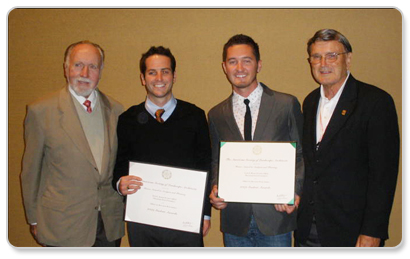OSU students bridge the gap from urban to rural communities
Thursday, September 24, 2009
By Sean Hubbard
STILLWATER, Okla. – “Reclaiming rural America” through the use of existing railway
infrastructure is a good idea.
Oklahoma currently owns more than 900 miles of railway, which is not utilized to its
full potential. That may change in the future after Oklahoma State University students,
Seth Slifer and Cody Klein, won the Analysis and Planning category with honors, the
highest student award from the American Society of Landscape Architects.
The ASLA is a professional society that recently re-accredited the landscape architecture
program at OSU’s Division of Agricultural Sciences and Natural Resources, continuing
its accreditation since 1985.
“There are about 60 schools in the ASLA, so the competition is pretty severe,” said
Charles Leider, professor and director of the landscape architecture program. “This
is the first time we have had students win the top award.”
Spending a ton of time of this project paid off for the seniors of the five-year program,
as they were presented with the award in Chicago at the annual ASLA conference in
Chicago.
Their topic, “OKRail 2025: Reclaiming Rural America” shows how a high-speed passenger
railroad from Tulsa to Oklahoma City, using available existing rail infrastructure,
could greatly benefit the geographical central location, City of Chandler. While the
project uses Chandler as its model city, the effects of a passenger railroad system
throughout the state offers hope to many other rural cities.
“Because of the convenience and affordability of automobile transportation, abundance
of cheap fuel supply, and available land use, an ever-growing problem of urban and
suburban sprawl have created a negative growth pattern in Oklahoma and across the
nation,” said Slifer, Kansas City, Kan. native. “This project focuses on initiatives
to create a more environmentally friendly transportation model including pedestrian-friendly
neighborhoods, alternative methods of mass transportation focusing on passenger rail
and connecting major metropolitan areas devoid of the automobile.”
After months of research, it was on to the design phase of their senior capstone project,
under the direction of the students’ advisor, John Ritter, associate professor of
horticulture and landscape architecture. Spending months on the design, Slifer and
Klein finally reached a conclusion they were satisfied with and submitted their project
for evaluation.
“The City of Chandler will serve as an inspiration for rural areas in Oklahoma and
across the nation,” said Klein, Little Rock, Ark. senior. “Proving that innovation
and vision can revitalize small towns to their once prosperous condition without sacrificing
the sense of pride in community that so many share.”
Included in the plan is a design for the Ninth Street Promenade and its transit hub
to serve as iconic structures for sustainability and green infrastructure.
“Bridging the gap between the eastern and western portions of Chandler, the Ninth
Street Promenade is an elevated boulevard with bike lanes, prominent sidewalks, mixed-use
zoning, and locale for the multi-modal transit hub,” said Slifer. “This viaduct creates
a safe and substantial crossing of the rail corridor while enhancing the aesthetic
appeal of Chandler.”
The roof of the transit hub is displayed with an extensive garden roof, demonstrating
green technologies such as solar and wind harvesting, rainwater collection and storage
for irrigation purposes and live roof plant species.
The 16-page report over the project goes into great detail to include an improvement
to the housing condition of Dewey Ave. on the east side of the rail corridor, creating
space for incoming businesses.
“This district will promote alternative means of transportation by including narrow
streets, bicycle lanes, interior parking, wide sidewalks and bioretention cells to
beautify the streets and collect and retain storm water runoff making them exceedingly
pedestrian-friendly,” Klein said. ”This will not only serve as a means to reduce dependence
on the automobile and oil, but also to promote a healthy lifestyle by encouraging
physical activity.”
Whether this plan is ever put into effect is yet to be determined, but Klein and Slifer
have done their part to connect small towns to the rest of the state, and nation.

